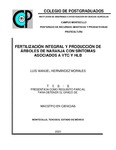| dc.description.abstract | La producción de cítricos presenta problemas de bajo rendimiento y calidad de frutos, relacionado con la incidencia del Virus Tristeza de los Cítricos (VTC) y Huanglongbing (HLB). La precipitación pluvial baja, temperaturas altas y uso de Citrus aurantium como portainjerto los hacen más vulnerables a las enfermedades. El uso de portainjertos tolerantes, programas de fertilización y control de vectores son alternativas para atenuar los daños y mantener productivos a los árboles. El objetivo fue evaluar el efecto de la fertilización al suelo y foliar con macro y micronutrimentos en la producción y comportamiento de los síntomas asociados a VTC y HLB, confirmados mediante PCR, en árboles de naranjo ‘Marrs’ (Citrus sinensis / C. volkameriana). Se trabajó en un huerto comercial de naranja de seis años, en producción, sin riego. Debido a la topografía irregular se seleccionaron árboles en las partes baja y alta del terreno; asintomáticos, con síntomas ligeros y avanzados asociados a VTC y HLB. El diseño experimental fue parcelas divididas en bloques al azar con tres repeticiones. Los tratamientos fueron fertilización química y orgánica al follaje, integrada con la fertilización química, orgánica y combinada al suelo. Antes de la fertilización, se realizó diagnóstico nutrimental mediante los índices DOP. Las variables fueron: incidencia de VTC y HLB, estatus nutrimental del árbol, síntomas de deficiencias nutrimentales en hojas, floración, amarre de fruto, rendimiento, composición mineral y calidad del fruto. La mayor incidencia para VTC fue de 47 % y para HLB de 64.7 % en la parte baja del huerto. Los índices DOP para N, S, Zn y Mn fueron más negativos en los árboles con síntomas ligeros y avanzados. El ORN fue Zn>Mn>Cu>P>B>Mg>K>Fe>N>S. La fertilización química y combinada al suelo y follaje incrementó la floración hasta 96 flores por metro cuadrado de dosel, y 89 frutos amarrados por rama principal. La falta de lluvia provocó severo estrés hídrico, que afectó la respuesta de los árboles a los tratamientos durante el desarrollo del fruto, por lo que se presentaron deficiencias de Zn y Mn, combinadas con moteado clorótico asimétrico en la lámina foliar y ramas secas. El rendimiento fue de 2 a 12 kg por árbol; con frutos de tamaño pequeño a mediano, con poco contenido de jugo, alto en azucares totales, en ácido cítrico y composición mineral con deficiencias de la mayoría de los nutrimentos con excepción del P, Ca y Cu. La incidencia y severidad de VTC y HLB reducen el estatus nutrimental de los árboles, aunado al estrés hídrico son dos factores que están limitando la producción de naranjo ‘Marrs’. _______________ INTEGRAL FERTILIZATION AND PRODUCTION OF ORANGE TREES WITH SYMPTOMS ASSOCIATED TO CTV AND HLB. ABSTRACT: Citrus production presents problems of the low yield and fruit quality, related to the incidence of Citrus Tristeza Virus (CTV) and Huanglongbing (HLB). Low rainfall, high temperatures, and the use of Citrus aurantium as rootstock make them more vulnerable to diseases. The use of tolerant rootstocks, fertilization programs, and vector control are alternatives to mitigate damage and keep trees productive. The objective was to evaluate the effect on the soil and foliar fertilization with macro and micronutrients on the production and behavior of the symptoms associated to CTV and HLB, confirmed by PCR, in 'Marrs' orange trees (Citrus sinensis / C. volkameriana). Work was done in a six-year commercial orange orchard, in production, without irrigation. Due to the irregular topography, trees were selected in the lower and upper parts of the terrain; asymptomatic, with light and advanced symptoms associated with VTC and HLB. The experimental design was plots divided into random blocks with three replications. The treatments were chemical and organic fertilization to the foliage mixture with chemical, organic, and combined fertilization to the soil. Before fertilization, a nutritional diagnosis was made using DOP indices. The variables were incidence of CTV and HLB, tree nutritional status, symptoms of nutritional deficiencies in leaves, flowering, fruit set, yield, mineral composition, and fruit quality. The highest incidence for CTV was 47% and for HLB 64.7% in the lower part of the orchard. The DOP indices for N, S, Zn, and Mn was more negative in trees with mild and advanced symptoms. The ORN was Zn>Mn>Cu>P>B>Mg>K>Fe>N>S. Chemical and combined fertilization to the soil and foliage increased flowering to 96 flowers per square meter of the canopy, and 89 fruit set by the main branch. The lack of rain caused severe water stress, which affected the response of the trees to the treatments during the development of the fruit, the reason why Zn and Mn deficiencies were present, combined with asymmetric chlorotic mottling in the leaf blade and dry branches. The yield was of 2 to 12 kg per tree with fruits of small to medium size, with little content of juice, high in total sugars, citric acid, and mineral composition with deficiencies of most nutrients except P, Ca, and Cu. The incidence and severity of CTV and HLB decrease the nutritional status of trees, coupled with water stress are two factors that are limiting the production of 'Marrs' orange. | es_MX |


